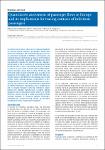Quantitative assessment of passenger flows in Europe and its implications for tracing contacts of infectious passengers
Askar, Mona
Mohr, Oliver
Eckmanns, Tim
Krause, Gérard
Poggensee, Gabriele
In contrast to air travel, there are no recommendations on tracing ground transport passengers exposed to infectious pathogens. We analysed European statistics on passenger transport in different conveyances and conducted expert workshops to discuss environmental conditions in ground transport, indications and minimal datasets required for contact tracing. Transport performance in the 27 countries of the European Union increased from 5.3x1012 passenger kilometres (pkm) in 1995 to 6.5x1012 pkm in 2007. Each resident generated on average 13,092 pkm in 2007, of which 2,062 pkm were public ground transport and 1,155 pkm in air transport. In the same year in Germany the total passenger volume in all different conveyances was 67,937 million. Public ground transport accounted for a passenger volume of 11,387 million (16.8%) and air transport for 129 million (0.2%). High efficiency particulate air (HEPA) filtration is frequently used in airplanes but not in ground transport vehicles. Therefore opportunities for disease transmission in public ground transport are not necessarily lower than in air travel. However, contact tracing is rarely conducted in these settings because of immense logistic challenges. Indication for contact tracing should be revisited, including all kinds of passenger transport.
No license information

